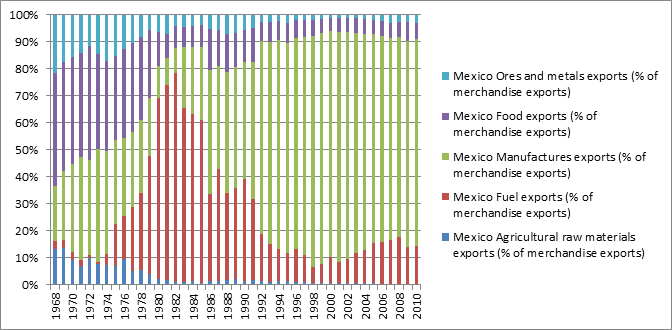Evolution of Latin America’s Economies
More on:
I’ve been looking recently at the structural changes in many of Latin America’s economies (through the evolution of their exports). The different trajectories are quite striking, as you can see in the graphs below.
Out of Latin America’s biggest economies, Mexico has transformed the most. In the 1980s the manufacturing sector comprised just 10 percent of total exports; today it is over 75 percent. Mexico’s economic diversification and dynamism, especially in the automotive and electronic industries, have held oil at a steady 10-15 percent of exports for the last twenty years, even as oil prices have risen (though, in fairness, production has also declined).
Next in the "most changed" category is Brazil. Over the last forty years, Brazil has moved away from a heavy reliance on food exports, and manufacturing has steadily risen—peaking at over 50 percent of exports in the 1990s and early 2000s. But the graph below also highlights Brazil’s continuing challenges: commodities have risen as a percentage of exports, leading manufacturing to slip to less than 40 percent of total exports in 2010 (back to early 1980s levels).
Colombia has followed a similar trajectory; moving away from food production and toward manufacturing (although never reaching near the same levels as Brazil). What has also increased substantially is oil production, jumping from under 2 percent in 1981 to reach some 60 percent of the country’s exports today. The combination of government incentives and expanding geographic safety suggests this upward trend will continue.
Interestingly, Chile, though rightly touted as one of the most open and advanced economies, remains in essence a commodity producer. Some areas have increased their value added—for instance, within food exports is the successful wine industry. But overall, copper dominates, bringing in roughly $41 billion a year, or nearly 60 percent of exports. Structurally, not much has changed in the last 30 years.
Finally, Venezuela has changed, though unlike its neighbors it has reverted to the past. Where manufacturing, food, and ore and metal exports rose steadily during the 1980s and 1990s (to total a combined 20 to 30 percent of exports), under the Chávez government they now comprise less than 7 percent. Over the last fifteen years, food and agricultural production have been wiped out, and oil dominates once again.
Taking this longer view, we see the direct benefits of high global commodity prices, bringing in billions of dollars each year to many of these economies. But we also see real structural changes. If a measure of maturing economies is their diversification (particularly toward manufacturing and services), then many of Latin America’s largest economies look to be moving in the right direction.
More on:
 Online Store
Online Store




